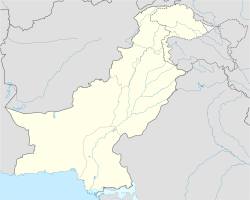Karakh Tehsil
Karakh
Balochi: تحصیل کارخ Karkh | |
|---|---|
 Impressions of Karakh | |
| Coordinates: 27°44′N 67°10′E / 27.733°N 67.167°E | |
| Country | |
| Province | Balochistan |
| District | Khuzdar District |
| Tehsil | Karakh |
| Area | |
• Tehsil of Khuzdar District | 1,352 km2 (522 sq mi) |
| Elevation | 794 m (2,605 ft) |
| Population (2023)[1] | |
• Tehsil of Khuzdar District | 35,990 |
| • Density | 26.62/km2 (68.9/sq mi) |
| • Rural | 35,990 |
| Literacy | |
| • Literacy rate | 32.14%[2] |
| Time zone | UTC+5 (PST) |
| Main language | 24,489 Brahui, 7,070 Sindhi, 4,255 Balochi[3] |
Karakh or locally also spelled Karkh (Brahui: کارخ; Balochi: کارخ, pronounced [kə.rəx]) is an administrative subdivision (tehsil) of Khuzdar District in Balochistan, Pakistan.[1] It is one of ten administrative units in the district, comprising tehsils and sub-tehsils, alongside Aranji, Gresha, Khuzdar, Nal, Moola, Ornach, Saroona, Wadh, and Zehri. Covering an area of 1,352 square kilometres, Karakh is predominantly defined by mountainous and arid terrain.
Geographically, the tehsil is located southeast of Moola Tehsil, east and northeast of Khuzdar Tehsil, and borders Jhal Magsi District to the west and Qambar Shahdadkot District in Sindh to the east.

Among its notable natural landmarks is the second-highest peak of the Central Brahui Range, part of the Kirthar Mountains, rising to an elevation of 2,096 metres. This peak is situated in Mouza Dhadaro, within Union Council Sunchuko, and is locally known as Kuttay Ji Qabar ("Dog's Grave" in Urdu) and Kuchak na Qabar in Brahui. The site holds cultural significance due to its association with a prominent Brahui folktale.[4][5] Located approximately 25 kilometres from the Sindh-Balochistan boundary, the area is subject to a jurisdictional dispute between the provincial governments of Sindh and Balochistan, primarily due to its perceived value as a protected heritage and tourism site.[6][7][8][9]
According to the 2023 national census, Karakh tehsil has a total population of 35,990, all residing in rural areas.[1] The tehsil encompasses 6,723 households, reflecting its predominantly rural character.[10]
The literacy rate in the tehsil stands at 32.14%, reflecting limited access to educational resources. This figure includes a male literacy rate of 39.70% and a significantly lower female literacy rate of 24.41%, highlighting a notable gender disparity in educational attainment.[2]
References
[edit]- ^ a b c "Table 1: Area, Population by Sex, Sex Ratio, Population Density, Urban Population, Household Size and Annual Growth Rate, Balochistan" (PDF). pbs.gov.pk. Pakistan Bureau of Statistics, Census. 2023. Retrieved 21 May 2025.
- ^ a b "Table 12 - Population (10 years and above) by Literacy Rate, Enrolment and Out of School Population by Sex and Rural/Urban, Census 2023" (PDF). pbs.gov.pk. Pakistan Bureau of Statistics. Retrieved 21 May 2025.
- ^ "Karakh (Tehsil, Pakistan)". citypopulation.de. 26 August 2024. Retrieved 21 May 2025.
- ^ Rashid, Salman (2 December 2011). "The dog's grave". tribune.com.pk. The Express Tribune. Retrieved 21 May 2025.
- ^ Shaikh, Abdul Razak (17 June 2019). "Kutte ji Kabar: a celebration of loyalty". dailytimes.com.pk. Daily Times. Retrieved 21 May 2025.
- ^ Ali, Kalbe (8 March 2025). "Sindh, Balochistan asked to resolve dispute over heritage site in 30 days". dawn.com. Dawn. Retrieved 21 May 2025.
- ^ Yasin, Asim (8 March 2025). "'Kuttay Ji Qabar' jurisdiction dispute sparks debate in Senate panel meeting". thenews.com.pk. The News International. Retrieved 21 May 2025.
- ^ "Sindh govt grants heritage status to a dog's grave in Qambar". tribune.com.pk. The Express Tribune. 2 October 2024. Retrieved 21 May 2025.
- ^ Jafrani, Shams (5 November 2024). "Tourism potential". dawn.com. Dawn. Retrieved 21 May 2025.
- ^ "Table 24: Housing Characteristics, Facilities of Toilet and Washroom Used by Households, Rural/Urban: Census 2023" (PDF). pbs.gov.pk. Pakistan Bureau of Statistics. 2023. Retrieved 21 May 2025.


